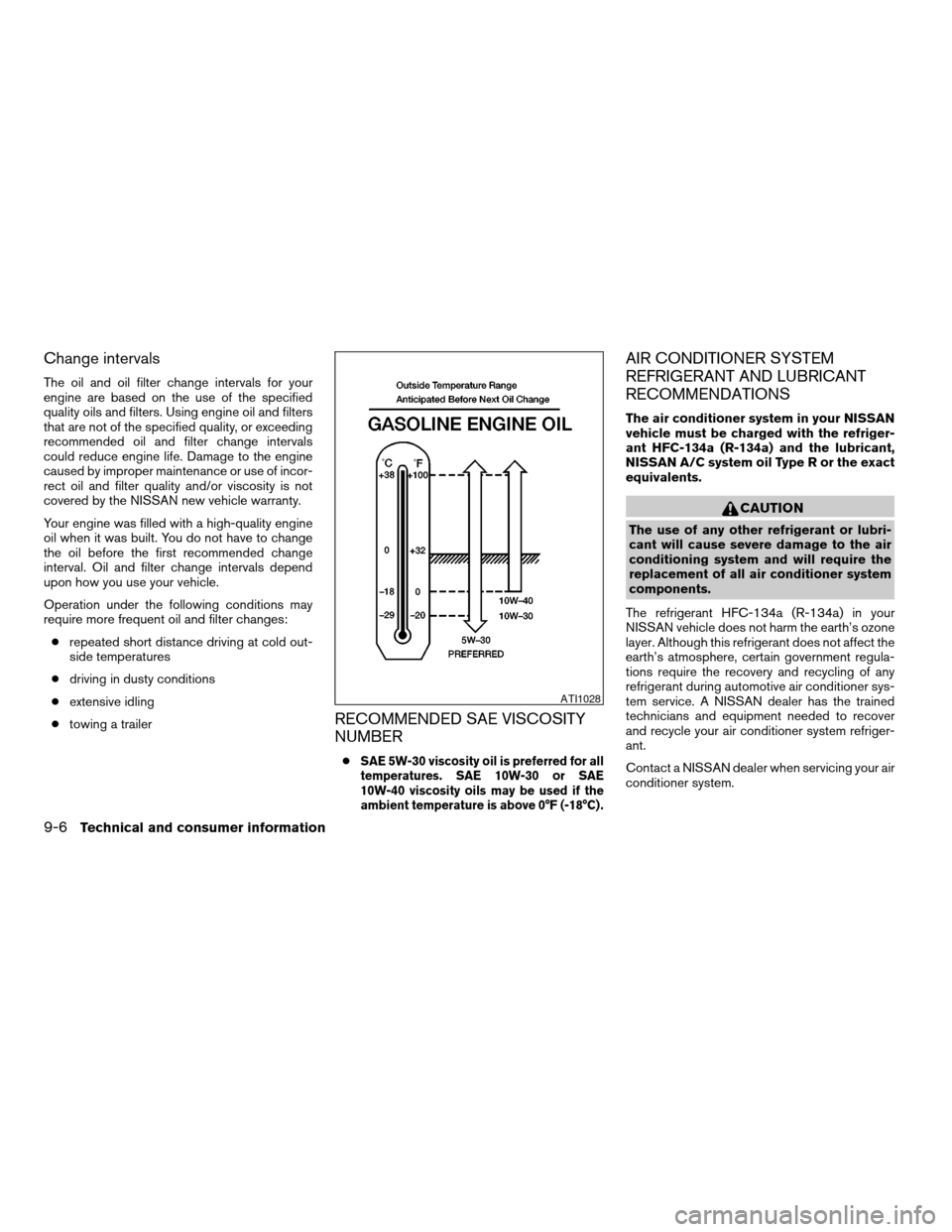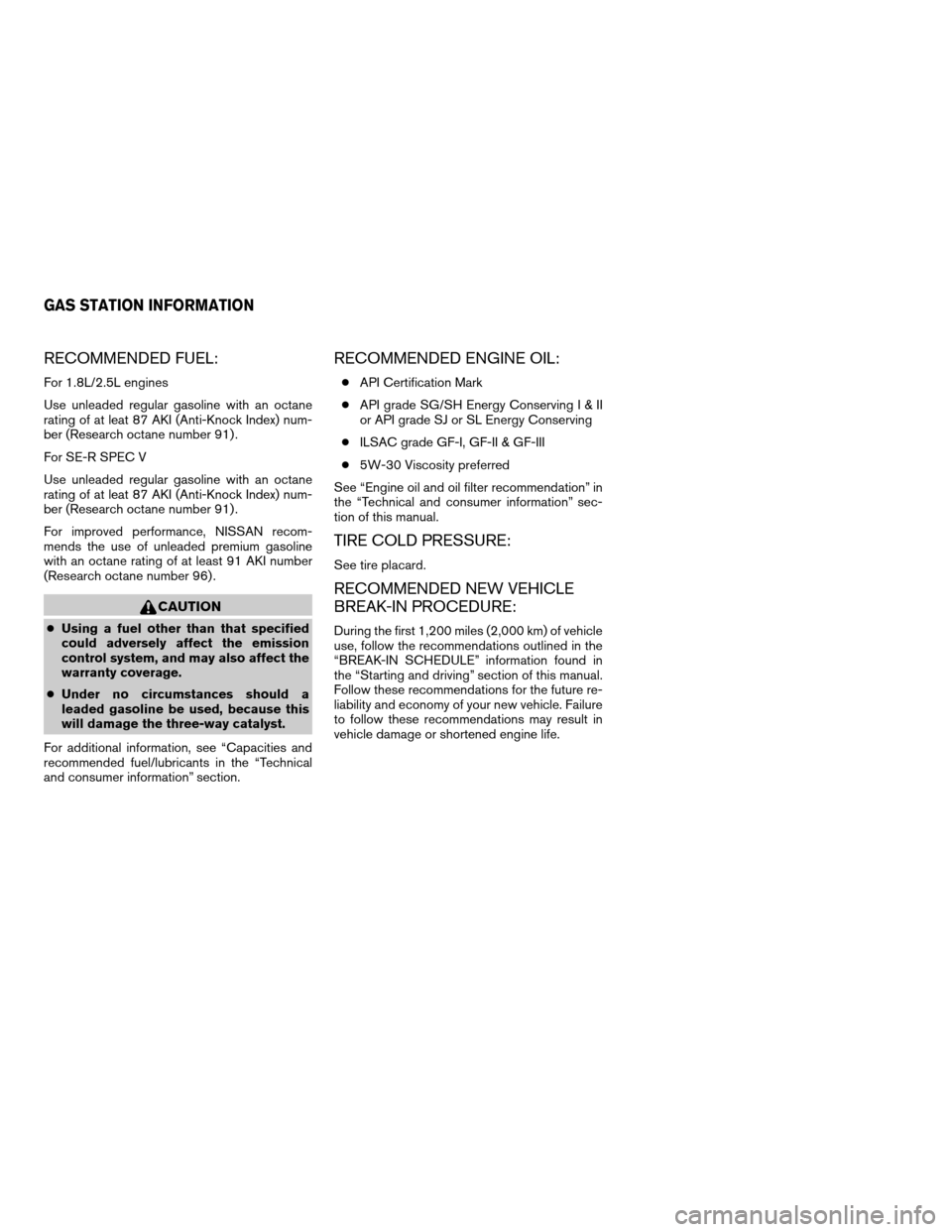2004 NISSAN SENTRA recommended oil
[x] Cancel search: recommended oilPage 218 of 248

Change intervals
The oil and oil filter change intervals for your
engine are based on the use of the specified
quality oils and filters. Using engine oil and filters
that are not of the specified quality, or exceeding
recommended oil and filter change intervals
could reduce engine life. Damage to the engine
caused by improper maintenance or use of incor-
rect oil and filter quality and/or viscosity is not
covered by the NISSAN new vehicle warranty.
Your engine was filled with a high-quality engine
oil when it was built. You do not have to change
the oil before the first recommended change
interval. Oil and filter change intervals depend
upon how you use your vehicle.
Operation under the following conditions may
require more frequent oil and filter changes:
crepeated short distance driving at cold out-
side temperatures
cdriving in dusty conditions
cextensive idling
ctowing a trailer
RECOMMENDED SAE VISCOSITY
NUMBER
cSAE 5W-30 viscosity oil is preferred for all
temperatures. SAE 10W-30 or SAE
10W-40 viscosity oils may be used if the
ambient temperature is above 0°F (-18°C) .
AIR CONDITIONER SYSTEM
REFRIGERANT AND LUBRICANT
RECOMMENDATIONS
The air conditioner system in your NISSAN
vehicle must be charged with the refriger-
ant HFC-134a (R-134a) and the lubricant,
NISSAN A/C system oil Type R or the exact
equivalents.
CAUTION
The use of any other refrigerant or lubri-
cant will cause severe damage to the air
conditioning system and will require the
replacement of all air conditioner system
components.
The refrigerant HFC-134a (R-134a) in your
NISSAN vehicle does not harm the earth’s ozone
layer. Although this refrigerant does not affect the
earth’s atmosphere, certain government regula-
tions require the recovery and recycling of any
refrigerant during automotive air conditioner sys-
tem service. A NISSAN dealer has the trained
technicians and equipment needed to recover
and recycle your air conditioner system refriger-
ant.
Contact a NISSAN dealer when servicing your air
conditioner system.
ATI1028
9-6Technical and consumer information
ZREVIEW COPY:Ð2004 Sentra(b15)
Owners Manual(owners)ÐUSA English(nna)
03/18/04Ðtbrooks
X
Page 230 of 248

Trailer towing tips
In order to gain skill and an understanding of the
vehicle’s behavior, you should practice turning,
stopping and backing up in an area which is free
from traffic. Steering stability and braking perfor-
mance will be somewhat different than under
normal driving conditions.
cAlways secure items in the trailer to prevent
load shift while driving.
cAvoid abrupt starts, acceleration or stops.
cAvoid sharp turns or lane changes.
cAlways drive your vehicle at a moderate
speed.
cAlways block the wheels on both vehicle and
trailer when parking. Parking on a slope is
not recommended; however, if you must do
so, and if your vehicle is equipped with an
automatic transmission, first block the
wheels and apply the parking brake, and
then move the transmission shift selector
lever into the P (Park) position. If you move
the shift selector lever to the P (Park) posi-
tion before blocking the wheels and applying
the parking brake, transmission damage
could occur.
cWhen going down a hill, shift into a lower
gear and use the engine braking effect.When going up a long grade, downshift the
transmission to a lower gear and reduce
speed to reduce chances of engine over-
loading and/or overheating. However, for
long steep grades, do not stay in 1st or 2nd
gear when driving above 35 MPH (56 km/h) .
cIf the engine coolant rises to an extremely
high temperature when the air conditioner
system is on, turn off the air conditioner.
Coolant heat can be additionally vented by
opening the windows, switching the fan
control to high and setting the temperature
control to the HOT position.
cTrailer towing requires more fuel than normal
circumstances.
cAvoid towing a trailer for your vehicle’s first
500 miles (805 km) .
cFor the first 500 miles that you do tow, do
not drive over 50 MPH (80 km/h) .
cHave your vehicle serviced more often than
at intervals specified in the recommended
Maintenance Schedule in the “NISSAN Ser-
vice and Maintenance Guide”.
cWhen making a turn, your trailer wheels will
be closer to the inside of the turn than your
vehicle wheels. To compensate for this,
make a larger than normal turning radius
during the turn.cCrosswinds and rough roads will adversely
affect vehicle/trailer handling, possibly caus-
ing vehicle sway. When being passed by
larger vehicles, be prepared for possible
changes in crosswinds that could affect ve-
hicle handling. If swaying does occur, firmly
grip the steering wheel, steer straight ahead,
and immediately (but gradually) reduce ve-
hicle speed. This combination will help sta-
bilize the vehicle. Never increase speed.
cBe careful when passing other vehicles.
Passing while towing a trailer requires con-
siderably more distance than normal pass-
ing. Remember, the length of the trailer must
also pass the other vehicle before you can
safely change lanes.
cTo maintain engine braking efficiency and
electrical charging performance, do not use
5th gear (manual transmission) or overdrive
(automatic transmission) .
cAvoid holding the brake pedal down too long
or too frequently. This could cause the
brakes to overheat, resulting in reduced
braking efficiency.
When towing a trailer, transmission
oil/fluid should be changed more fre-
quently. For additional information, see the
“Maintenance and do-it-yourself” section
earlier in this manual.
9-18Technical and consumer information
ZREVIEW COPY:Ð2004 Sentra(b15)
Owners Manual(owners)ÐUSA English(nna)
03/18/04Ðtbrooks
X
Page 238 of 248

Checking engine coolant level........8-8
Engine coolant temperature gauge.....2-7
Corrosion protection...............7-5
Cruise control..................5-14
Cup holders...................2-24
D
Daytime running light system
(Canada only)..................2-19
Defogger switch
Rear window defogger switch.......2-18
Door locks....................3-3
Door open warning light............2-10
Drive belts....................8-21
Driving
Cold weather driving............5-20
Driving with automatic transmission.....5-7
Driving with manual transmission.....5-10
Precautions when starting and driving . . .5-2
E
Economy - fuel.................5-16
Emission control information label.......9-11
Emission control system warranty.......9-20
Engine
Before starting the engine..........5-6
Capacities and recommended
fuel/lubricants.................9-2
Changing engine coolant..........8-9
Changing engine oil............8-12
Changing engine oil filter..........8-13
Checking engine coolant level........8-8Checking engine oil level..........8-11
Engine compartment check locations. . . .8-8
Engine coolant temperature gauge.....2-7
Engine cooling system............8-8
Engine oil..................8-11
Engine oil and oil filter recommendation . .9-5
Engine oil viscosity..............9-5
Engine serial number............9-10
Starting the engine..............5-6
Engine oil pressure low/engine coolant
temperature high warning light.........2-10
Event data recorders..............9-22
Exhaust gas (Carbon monoxide)........5-2
F
Flashers (See hazard warning flasher switch)
..........................2-20
Flat tire......................6-2
Floor mat positioning aid.............7-4
Fluid
Automatic transmission fluid (ATF). . . .8-14
Brake fluid..................8-17
Capacities and recommended
fuel/lubricants.................9-2
Clutch fluid.................8-18
Engine coolant................8-8
Engine oil..................8-11
Power steering fluid.............8-17
Window washer fluid............8-19
F.M.V.S.S. certification label..........9-10
Fog light switch.................2-20
Folding rear seat.................1-4
Front seats....................1-2Fuel
Capacities and recommended
fuel/lubricants.................9-2
Fuel economy................5-16
Fuel filler cap................3-14
Fuel filler lid.................3-14
Fuel filler lid and cap............3-14
Fuel filler lid lock opener lever.......3-14
Fuel gauge..................2-7
Fuel octane rating..............9-4
Fuel recommendation............9-3
Fuses......................8-30
Fusible links...................8-30
G
Gascap.....................3-14
Gauge
Engine coolant temperature gauge.....2-7
Fuel gauge..................2-7
Odometer...................2-4
Speedometer.................2-4
Tachometer..................2-6
Trip odometer.................2-4
General maintenance..............8-2
Glove box....................2-24
H
Hazard warning flasher switch.........2-20
Head restraints..................1-5
Headlight aiming adjustment..........8-34
Headlight and turn signal switch........2-18
Headlights....................8-34
10-2
ZREVIEW COPY:Ð2004 Sentra(b15)
Owners Manual(owners)ÐUSA English(nna)
04/02/04Ðdebbie
X
Page 240 of 248

O
Octane rating (See fuel octane rating).....9-4
Odometer.....................2-4
Oil
Capacities and recommended
fuel/lubricants.................9-2
Changing engine oil............8-12
Changing engine oil filter..........8-13
Checking engine oil level..........8-11
Engine oil..................8-11
Engine oil and oil filter recommendation . .9-5
Engine oil pressure low/engine coolant
temperature high warning light.......2-10
Engine oil viscosity..............9-5
Outside mirrors.................3-16
Overdrive switch................5-10
Overheat
If your vehicle overheats..........6-10
Owner’s manual order form..........9-23
Owner’s manual/service manual order
information....................9-23
P
Parking
Parking brake check............8-28
Parking brake operation..........5-13
Parking/parking on hills...........5-17
Power
Power door locks...............3-4
Power outlet.................2-21
Power rear windows............2-27
Power steering fluid.............8-17Power steering system...........5-18
Power windows...............2-26
Rear power windows............2-27
Precautions
Maintenance precautions..........8-5
Precautions on child restraints.......1-26
Precautions on seat belt usage......1-18
Precautions on supplemental restraint
system.....................1-6
Precautions when starting and driving . . .5-2
Push starting...................6-9
R
Radio
Car phone or CB radio...........4-17
FM-AM radio with compact disc (CD)
player....................4-13
Readiness for inspection maintenance (I/M)
test........................9-21
Rear power windows..............2-27
Rear seat.....................1-4
Rear window defogger switch.........2-18
Recorders
Event data..................9-22
Refrigerant recommendation..........9-6
Registering your vehicle in another country. . .9-9
Remote keyless entry system..........3-5
Reporting safety defects (US only)......9-21
S
Safety
Child safety rear door lock..........3-5Child seat belts...............1-26
Reporting safety defects (US only). . . .9-21
Seat adjustment
Front manual seat adjustment........1-2
Seat belt
Child safety.................1-20
Infants and small children.........1-21
Injured Person................1-21
Larger children...............1-21
Precautions on seat belt usage......1-18
Pregnant women..............1-21
Seat belt extenders.............1-25
Seat belt maintenance...........1-25
Seat belts..................1-18
Shoulder belt height adjustment......1-24
Three-point type with retractor.......1-22
Seat belt warning light.............2-11
Seats
Adjustment..................1-2
Front seats..................1-2
Manual front seat adjustment........1-2
Rear seat...................1-4
Security system (Nissan vehicle immobilizer
system) , engine start.........2-13, 3-2, 5-5
Self-adjusting brakes..............8-29
Service manual order form...........9-23
Servicing air conditioner.............4-9
Shift lock release.................5-9
Shifting
Automatic transmission...........5-8
Manual transmission............5-11
Shoulder belt height adjustment........1-24
Spark plug replacement............8-22
Speedometer...................2-4
Spotlights (See map light)...........2-30
SRS warning label...............1-16
10-4
ZREVIEW COPY:Ð2004 Sentra(b15)
Owners Manual(owners)ÐUSA English(nna)
04/02/04Ðdebbie
X
Page 247 of 248

RECOMMENDED FUEL:
For 1.8L/2.5L engines
Use unleaded regular gasoline with an octane
rating of at leat 87 AKI (Anti-Knock Index) num-
ber (Research octane number 91) .
For SE-R SPEC V
Use unleaded regular gasoline with an octane
rating of at leat 87 AKI (Anti-Knock Index) num-
ber (Research octane number 91) .
For improved performance, NISSAN recom-
mends the use of unleaded premium gasoline
with an octane rating of at least 91 AKI number
(Research octane number 96) .
CAUTION
cUsing a fuel other than that specified
could adversely affect the emission
control system, and may also affect the
warranty coverage.
cUnder no circumstances should a
leaded gasoline be used, because this
will damage the three-way catalyst.
For additional information, see “Capacities and
recommended fuel/lubricants in the “Technical
and consumer information” section.
RECOMMENDED ENGINE OIL:
cAPI Certification Mark
cAPI grade SG/SH Energy ConservingI&II
or API grade SJ or SL Energy Conserving
cILSAC grade GF-I, GF-II & GF-III
c5W-30 Viscosity preferred
See “Engine oil and oil filter recommendation” in
the “Technical and consumer information” sec-
tion of this manual.
TIRE COLD PRESSURE:
See tire placard.
RECOMMENDED NEW VEHICLE
BREAK-IN PROCEDURE:
During the first 1,200 miles (2,000 km) of vehicle
use, follow the recommendations outlined in the
“BREAK-IN SCHEDULE” information found in
the “Starting and driving” section of this manual.
Follow these recommendations for the future re-
liability and economy of your new vehicle. Failure
to follow these recommendations may result in
vehicle damage or shortened engine life.
GAS STATION INFORMATION
Zb15Ðnna -
Owners Manual(owners)ÐUSA English(nna)
04/02/04Ðdebbie
X